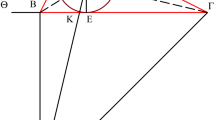Abstract
Geometry is an ancient discipline dealing with mathematical shapes and patterns, which the ancient Greeks, especially Plato, called “ideas”. In the nineteenth century, when idealism flourished again, geometry went through a phase of re-foundation that made it a modern system of thought, fundamental to cultural and technological development. Through the drafting of programmes and manifestos, typical of that century, it came out of the narrow Euclidean environment and offered mathematicians greater prospects and different choices to interpret the space around us (or in which we address our problems). In this paper, I present some contemporary geometric research programmes, in mathematics as well as in other disciplines, their state of advancement and their applications.








Similar content being viewed by others
References
Birkar, C., Cascini, P., Hacon, C.D., McKernan, J.: Existence of minimal models for varieties of log general type. J. Am. Math. Soc. 23, 405–468 (2010)
Cohen, J.E.: Mathematics is biology’s next microscope, only better; biology is mathematics’ next physics, only better. PLoS Biol 2(12), e439 (2004). doi:10.1371/journal.pbio.0020439
Higgs, P.W.: Broken Symmetries and the masses of gauge bosons. Phys. Rev. Lett. 13, 508–509 (1964)
Kac, M., Rota, G.-C., Schwartz, J.T.: Discrete thoughts: essays on mathematics, science and philosophy. Birkhäuser, Basel (1992)
Kant, I.: The critique of pure reason. J.M.D. Meiklejohn, transl. http://www.gutenberg.org/files/4280/4280-h/4280-h.htm. (1787). Accessed 1 June 2017
Legendre, G.L.: Pasta by design. Thames & Hudson, London (2011)
Mumford, D.: The dawning of the age of stochasticity. Mathematics: frontiers and perspectives, Accademia Nazionale dei Lincei, Rome, 197–218. http://www.dam.brown.edu/people/mumford/beyond/papers/2000b--DawningAgeStoch-NC.pdf. (2000). Accessed 1 June 2017
Riemann, B.: Über die Hypothesen, welche der Geometrie zu Grunde liegen. Abh. Kgl. Ges. Wiss. 13, 133–152. http://www.emis.de/classics/Riemann/. (1868). Accessed 1 June 2017. (Eng. transl.: On the hypotheses which lie at the foundation of geometry. W.K. Clifford, transl. Nature 8, 14–17, 36–37 (1873))
Author information
Authors and Affiliations
Corresponding author
Rights and permissions
About this article
Cite this article
Andreatta, M. O for Orientation. Lett Mat Int 5, 155–162 (2017). https://doi.org/10.1007/s40329-017-0178-0
Published:
Issue Date:
DOI: https://doi.org/10.1007/s40329-017-0178-0




